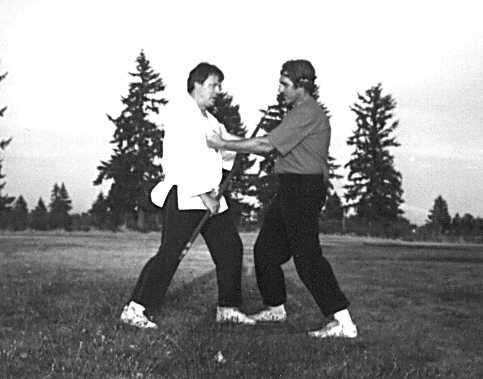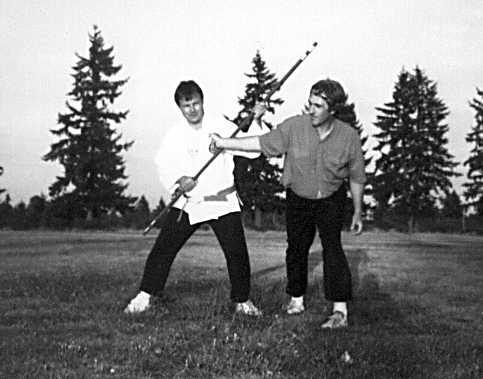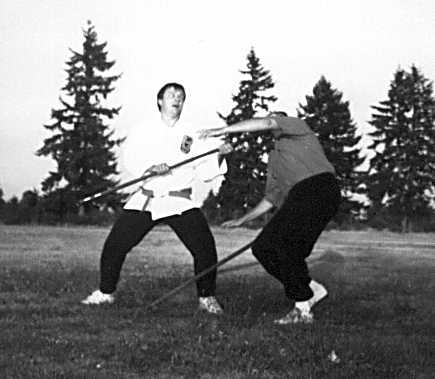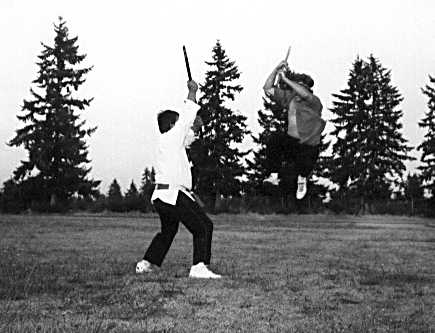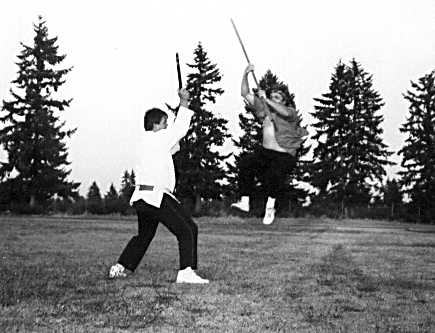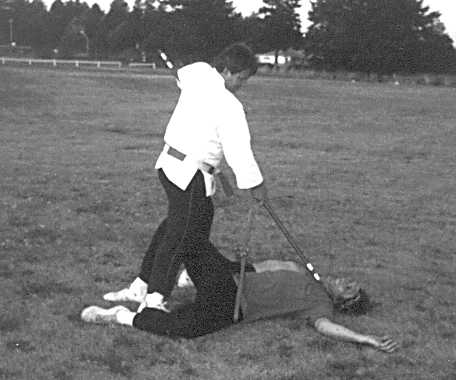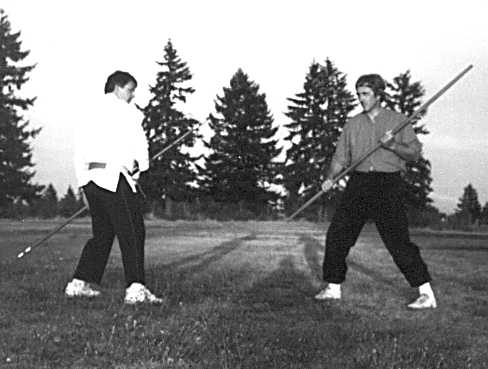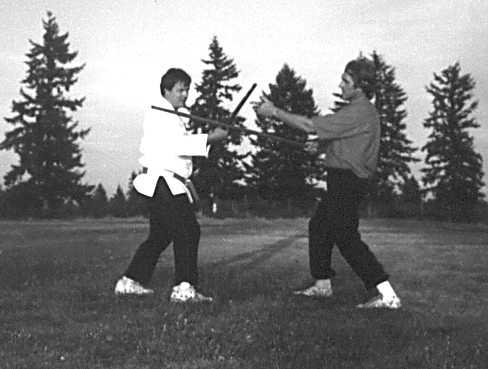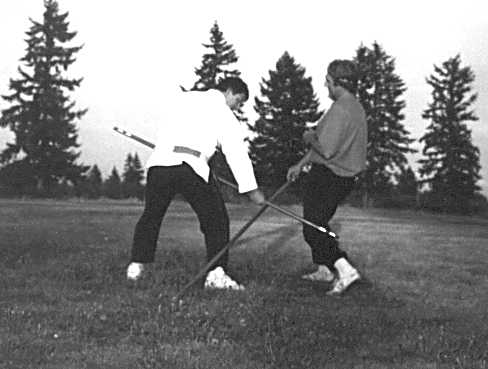|
Gunnosuke’s Bo
Please...if you like
coming, lend your support! If you benefit from
what you find here, show your appreciation with a
contribution. Doing so will assure our continued
presence on line. As it stands, we are extended to the
limit of available resources. Cast your vote with a
contribution.
Click the image below and make a
donation! WE REALLY NEED YOUR HELP!!!
Please note that Iron Crane Dojo is not
a “not for profit” organization. Donations are not
tax deductible. Whether you able to donate or not,
please understand you will remain our friend and
continue to be welcomed at Iron Crane Dojo.
After the duel, Muso Gunnosuke had years
to contemplate his defeat.
His reputation as a swordsman had stood unthreatened
until that fateful day he met the unorthodox challenger.
It was a challenge he could not refuse. The upstart
Musashi was single-handedly redefining the art of bladed
strategy. Putting Musashi in his rightful place would
surely further Muso's own aspirations for a position at
court.
Muso remembers entering the arena. He approached the
clearing cautiously, holding the honored family sword
out and to the front, showing respect and courtesy to
his opponent.
 The
challenger sat unkempt, his topknot hidden by a soiled
towel. The face beneath, unshaven. If one's nose could
be trusted, he was unbathed. The
challenger sat unkempt, his topknot hidden by a soiled
towel. The face beneath, unshaven. If one's nose could
be trusted, he was unbathed.
"So this is Miyamato Musashi. The stuff legends are made
of,” thought Muso Gunnosuke.
Nodding his head gruffly, Musashi jumped to his feet,
reached for a wooden staff, then broke it in two against
his knee. Placing the shorter segment in his right hand,
the longer in his left, he stared deeply into Gunnosuke,
"To the death?"
Gunnosuke nodded, then assumed the battle ready
position.
What followed was to become forever the
hard substance of Gunnosuke's dreams, or should we say
nightmares.
Musashi was a genius; Gunnosuke, simply a great
swordsman. The blow to Gunnosuke's head might have been
fatal, except Musashi held firm as it touched contact.
After the loss, Gunnosuke retired from the path of
influence, dedicating his every moment to removing those
distractions which had slowed his responses to Musashi's
attacks.
When they met again, Muso Gunnosuke arrived with a
staff, as had Musashi on the first occasion. Years of
meditation had quieted Muso's spirit. If the raging sea
became still, the ship could sail in all directions with
ease. He had forsaken all, even his family sword.
Thoughts of dividends at court no longer distracted his
focus. He served no master, save for his technique. He
stood before Musashi as an equal, a kindred spirit.
Recognizing this, Musashi smiled in acknowledgment.
The joust commenced at dawn's first light. To honor the
rivalry, Musashi wore full Samurai regalia.
Their blows stirred the morning breeze as they flowed
like two boats, drifting wildly on a raging stream
beneath the forest canopy.
Gunnosuke knew he could never match the fury of
Musashi's twin swords.
He chose the Bo because it gave him needed distance from
the blistering slashes. His sword technique could not
survive Musashi's at close quarter. Using a Bo, the
extra sliver of time might be all he needed to open his
counter.
During the years since the first match, Gunnosuke
synthesized a strategy to neutralize Musashi's movement.
Against Musashi, even the slightest error could result
in loss of limb, or death. Gunnosuke's new fight
embodied short definitive blocks, followed instantly by
bone crunching counters. Completing this concept, he
incorporated tactics from other masters, employing a
wide range of sweeps, takedowns and pressure point
attacks.
The contest continued for hours. The defenses of both
masters were complete. Late in the afternoon, as
Gunnosuke committed to strike #7 of the well-rehearsed
12 strike sequence, Musashi angled slightly left. Though
a lesser man would have seen nothing, Gunnosuke knew
Musashi had stumbled. As the swordsman adjusted, strike
#8 locked onto its mark. Gunnosuke angled the Bo
one-half body width to the right in a vicious downward
arc aimed to extinguish the flame that was history's
greatest swordsman.
The power tip of the Bo met Musashi's brow, stopping as
it touched. Musashi stepped back and placed his weapons
on the ground.
Gunnosuke had won!
Gunnosuke's success over Musashi opened the door for
acceptance of the Jo (5 foot staff) and later the Bo
(full size staff) as legitimate pursuits in the Japanese
fighting arts.
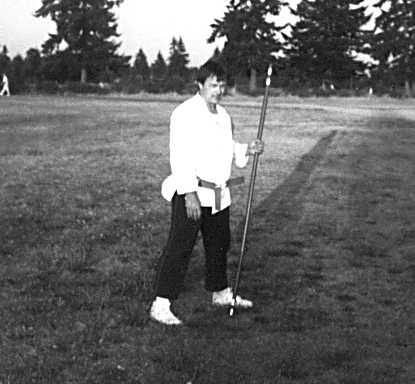 Sensei Donald Wasielewski (8th dan
Isshinryu) explains that the techniques developed by
Gunnosuke and his successors eventually took root on the
island archipelago of Okinawa. Though the sword remained
weapon of choice on the mainland, elsewhere bladed
weapons were unavailable to common folk. The Bo became
the natural first alternative. For Okinawans, the
man-sized staff was always within easy reach. Sensei Donald Wasielewski (8th dan
Isshinryu) explains that the techniques developed by
Gunnosuke and his successors eventually took root on the
island archipelago of Okinawa. Though the sword remained
weapon of choice on the mainland, elsewhere bladed
weapons were unavailable to common folk. The Bo became
the natural first alternative. For Okinawans, the
man-sized staff was always within easy reach.
The essence of Gunnosuke's fighting tactics and of
Okinawan Bo is tranquility. It would be highly
uncharacteristic for one of the island masters to
exercise a circular rotation or spin as part of his or
her fight. From its platform of stillness, the Bo must
be responsive explains Wasielewski, "As a defensive
weapon, it is without match. When responding, the
strikes are short, quick and incapacitating." Echoing
the precepts of Tatsuo Shimabuku (founder of Isshinryu)
he adds, "The time to respond is when the opportunity
presents itself."
At the basic level, students learn this by reacting
against grabbing attacks.
|
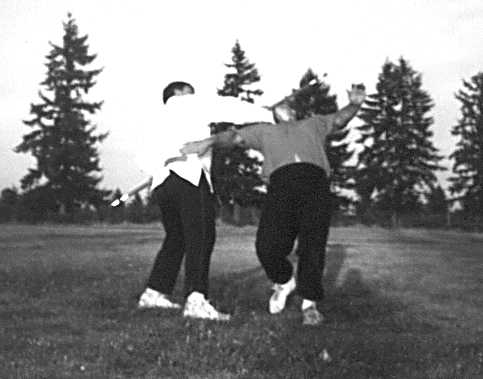
Photo Sequence #1
(Bo Against Two Handed Grab):
Attacker
grabs defender's clothing, getting "inside"
the Bo. Defender simultaneously breaks the
hold and delivers a head strike, all in one
movement. A full power, opposing direction
strike concludes the encounter.
|
A preferred clearing move is to "fan"
the Bo against the grabbing arms while pivoting from one
side to the other. This breaks the hold, exposing the
opponent to counter. Almost always, the counter flows
naturally from the pivot.
Once the clearing moves are perfected, the practitioner
advances to defenses against an attacking Bo or Sword.
"We learn to meet an attack with confidence, then
counter without hesitation. Though there are infinite
variations, it is understood the Bo moves no further
than two feet from the point of block to the point of
first strike in counter. Most likely, it was
proper positioning, combined with ability to find the
nearest vital target that gave victory to Gunnosuke,"
according to Wasielewski.
Photo Sequence #2 (Bo
Against Striking Bo):
Reacting against the common "side"
strike, Sensei Wasielewski wards off the strike, then
executes a head counter, all the while maintaining the
Bo in proper defensive "chamber."
Bo training at the highest level
involves reacting to street attacks. These include
attacks using maximum power and speed as well as out of
the ordinary attacks like airborne strikes with full
commitment. Wasielewski adds, "In this context, the
principle of stillness becomes paramount. Here the
martial artist must truly learn to 'accept' the incoming
attack, meet it with conviction, then counter
decisively."
|
|
|
Photo
Sequence #3:
(Bo Against Airborne Bo)
Defender
chooses to remain still against the "aerial"
onslaught. Once the attack is met and the
"opportunity presents itself", defender
arches forward, driving the attacker
backwards to the ground.
|
Tatsuo Shimabuku taught that the Bo, as
a line in physical space, becomes an impenetrable wall
when positioned effectively against an attack. Behind
the wall, the protected defender sets up the strongest
possible counter.
Learning to string moves effortlessly into sequences
characterizes the final element of Bo mastery. Facing
Musashi the second time, Gunnosuke no longer had gaps in
his motion. Against Musashi's twin blades, the moves
were there in sequence, as needed. When the opportunity
arose, the decisive strike materialized.
|
|
|
Photo
Sequence #4:
(Basic Takedown)
Strength can
be hidden in weakness, as defender executes
a powerful off-angle block, delivering
energy from his turning hips into the
attacker's gripping hand. A quick follow-up
to the rear left knee pressure point drops
opponent to the ground, where he is quickly
dealt with.
|
Sensei Wasielewski summarizes, "The
martial arts world is full of people practicing
baseball-bat, handlebar, baseball-bat striking drills
without becoming effective Bo tacticians. In a nutshell,
the master remains still and unaffected under duress,
then counters without hesitation ... but only when an
opening presents itself."
Closing the loop, Sensei Wasielewski adds one final
wrinkle to the saga of Gunnosuke and Musashi.
After going undefeated for many more years, Musashi
retired to the mountains, essentially living as a
hermit. He occasionally painted (his works of art exist
today as priceless treasures in the Orient) and
ultimately penned his Book of Strategy.
Wasielewski says he sometimes entertains
the thought a third meeting occurred between the two.
Though lifetimes of achievement had passed between them,
Musashi cautioned Gunnosuke not to place more emphasis
on the "apparent" victory than was due.
Sensing Gunnosuke's puzzlement, Musashi explained that
the second joust had gone according to plan, nothing
more, nothing less.
"If you could not be defeated and had the choice of
extinguishing a wonderful spark or accepting a token
defeat so that it could flourish, what would you have
done?"
Acknowledging the Master's comments, Gunnosuke bowed
humbly three times, then left to forge his own unique
path into history.
|

 The
challenger sat unkempt, his topknot hidden by a soiled
towel. The face beneath, unshaven. If one's nose could
be trusted, he was unbathed.
The
challenger sat unkempt, his topknot hidden by a soiled
towel. The face beneath, unshaven. If one's nose could
be trusted, he was unbathed. Sensei Donald Wasielewski (8th dan
Isshinryu) explains that the techniques developed by
Gunnosuke and his successors eventually took root on the
island archipelago of Okinawa. Though the sword remained
weapon of choice on the mainland, elsewhere bladed
weapons were unavailable to common folk. The Bo became
the natural first alternative. For Okinawans, the
man-sized staff was always within easy reach.
Sensei Donald Wasielewski (8th dan
Isshinryu) explains that the techniques developed by
Gunnosuke and his successors eventually took root on the
island archipelago of Okinawa. Though the sword remained
weapon of choice on the mainland, elsewhere bladed
weapons were unavailable to common folk. The Bo became
the natural first alternative. For Okinawans, the
man-sized staff was always within easy reach.